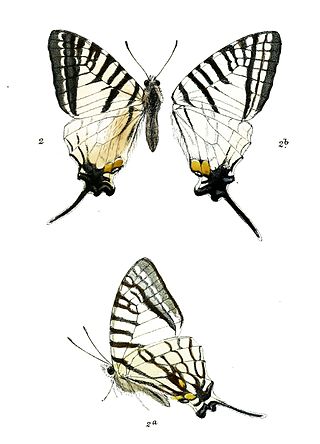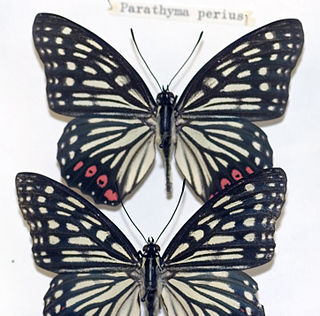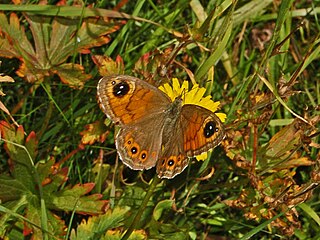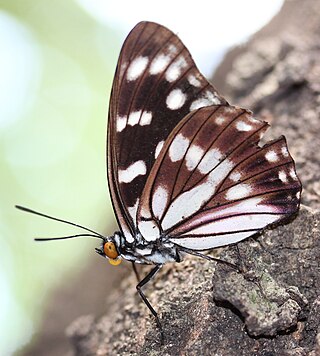
Arisaema is a large and diverse genus of the flowering plant family Araceae. The largest concentration of species is in China and Japan, with other species native to other parts of southern Asia as well as eastern and central Africa, Mexico and eastern North America. Asiatic species are often called cobra lilies, while western species are often called jack-in-the-pulpit; both names refer to the distinctive appearance of the flower, which consists of an erect central spadix rising from a spathe.

Papilio machaon, the Old World swallowtail, is a butterfly of the family Papilionidae. The butterfly is also known as the common yellow swallowtail or simply the swallowtail. It is the type species of the genus Papilio. This widespread species is found in much of the Palearctic and in North America.

Cepora nerissa, the common gull, is a small to medium-sized butterfly of the family Pieridae, that is, the yellows and whites, which is native to Sri Lanka, India, China, southeast Asia, and Indonesia.

Byasa polyeuctes, the common windmill, is the most common member in India of the windmills genus (Byasa), comprising tailed black swallowtail butterflies with white spots and red submarginal crescents.

Graphium eurous, the sixbar swordtail, is a swallowtail butterfly belonging to the genus Graphium, also known as the swordtails.

Parnassius stoliczkanus, the Ladakh banded Apollo, is a rare high-altitude butterfly which is found in Central Asia. It is a member of the snow Apollo genus (Parnassius) of the swallowtail family. It is named after the naturalist and explorer Ferdinand Stoliczka.

Heliophorus epicles, commonly known as the purple sapphire, is a species of lycaenid or blue butterfly found in Asia. The species was first described by Jean Baptiste Godart in 1823.

Hestina assimilis, the red ring skirt, is a species of butterfly in the family Nymphalidae found in Asia. It is generally of large size. There are several subspecies: H. a. assimilis, H. a. formosana (Moore, H. a. shirakii, and H. a. f. nigrivena

Hestina is a genus of butterflies in the family Nymphalidae subfamily Apaturinae. The genus is found in the East Palearctic and Southeast Asia.

The dark-breasted rosefinch is a species of true finch in the monotypic genus Procarduelis. It is found in Bhutan, China, India, Laos, Myanmar, Nepal, Pakistan, Thailand, and Vietnam. Its natural habitats are boreal forests and subtropical or tropical high-altitude shrubland.

The bar-throated minla or chestnut-tailed minla, or even bar-throated siva, is a species of bird in the laughingthrush and babbler family Leiothrichidae. Traditionally, it has been placed in the genus Minla but is now placed in Actinodura.

Neottia is a genus of orchids. The genus now includes the former genus Listera, commonly known as twayblades referring to the single pair of opposite leaves at the base of the flowering stem. The genus is native to temperate, subarctic and arctic regions across most of Europe, northern Asia, and North America, with a few species extending into subtropical regions in the Mediterranean, Indochina, the southeastern United States, etc.
The West Himalayish languages, also known as Almora and Kanauric, are a family of Sino-Tibetan languages centered in Himachal Pradesh, Uttarakhand and across the border into Nepal. LaPolla (2003) proposes that the West Himalayish languages may be part of a larger "Rung" group.

Lasiommata is a genus of butterflies of the subfamily Satyrinae in the family Nymphalidae.

Neope yama, the dusky labyrinth, is a species of satyrine butterfly found in Asia. In the Himalayas it is common from the eastern Himalayas to eastern Nepal and less common from western Nepal to Himachal Pradesh.

Areas galactina is a moth of the family Erebidae. It was described by Jan van der Hoeven in 1840. It is found in China, Taiwan, the north-western Himalayas, India, Nepal, Bhutan, Bangladesh, Indochina, the Philippines, Indonesia and Sundaland.

Lemyra stigmata is a moth of the family Erebidae. It was described by Frederic Moore in 1865. It is found in China, Pakistan, India, Nepal, Bhutan, Myanmar, Thailand and Vietnam.

Hestina persimilis, the siren, is an East Palearctic species of siren butterfly (Apaturinae) found in western China, Simla to Assam, Orissa. The larva feeds on Celtis australis.

Hestina japonica is an East Palearctic species of siren butterfly found in Japan and Korea.

















